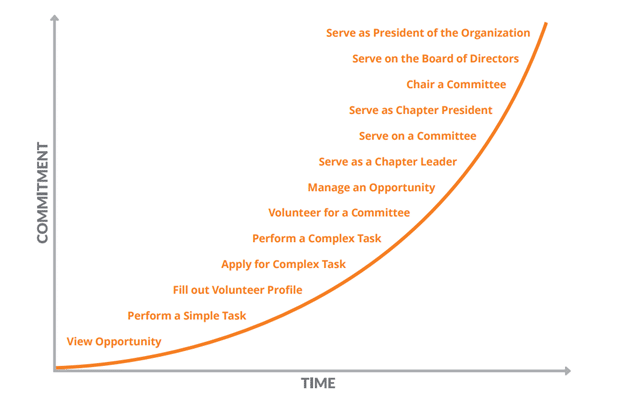
10 min read
Association Volunteer Programs and Online Community
Learn Tips for Using Community to Drive Volunteer and Member Engagement
Tags: Community Strategy,Member Engagement,Volunteer Programs
Your Volunteer Experience
Volunteers are an integral part of many organizations’ success and serve as an excellent way to foster member engagement. The great news is, the desire to volunteer is already present in most associations – members want to give back and stay connected. So the key to successful volunteer programs is:
- Making sure you set clear goals and guidelines.
- Communicating effectively with members about open volunteer opportunities, how they can get involved, and how they can benefit.
- Creating structures for feedback and measurement so you can evaluate how your volunteer programs are performing and whether they’re helping your organization achieve its mission.
Every volunteer program should also include options and flexibility, so that potential volunteers can engage at any level and choose volunteer roles that meet their interests. Your organization may offer multiple volunteer opportunities – from task-based projects, to event and conference support, to board appointments and committees on a variety of industry issues. The lifecycle of an avid volunteer often starts with small tasks or virtual participation, working all the way up to committee involvement and leadership positions.
Let’s explore some considerations for your association’s volunteer programs, as well as some ways your online community can support those programs.
Volunteer Types
Considering the ways your volunteer opportunities are structured, and ensuring you’re incorporating a variety of options can help your association develop a more diverse pipeline of volunteers. Opportunities that require a low level of commitment often attract a higher volume of volunteers and create inroads for those members who are looking to get more involved. Your association can then follow up with those hand-raisers when there are future volunteer opportunities that might require more investment.
While there can be innumerable volunteer roles within any association, most fit into one of two types:
Term-Based
Where a volunteer performs a service for the organization that is based on a time commitment. Examples: committee participation or chapter leaderships that have one-year terms
Task-Based
Where a volunteer works on a project that is typically short-term, focused on specific outcomes and aligned with a volunteer’s skill set. Examples: a volunteer participates in a welcome breakfast to help orient new conference attendees.
You might also think about your volunteer opportunities aligning with some of the following terms:
Micro-volunteering
Small, discreet tasks that are mission-related and done at a volunteer’s convenience. These opportunities often lend themselves to mass-mobilization. Examples: Sharing or promoting the organization’s content on social media platforms to increase visibility and support.
Virtual volunteering
Opportunities enabled by technology that do not require face-to-face interactions to complete tasks. Examples: Offering online mentoring, serving as a webinar presenter, or writing a piece of content (like a blog post) for your organization.
Episodic volunteering
Temporary, often smaller-scale opportunities or tasks that generally require short increments of time (one hour/day/week/month). Example: A one-hour focus group asking members to weigh in on a new member benefit.
Inviting and Tracking Volunteers
Make it easy for members to opt-in
Streamline the volunteer sign-up process to make it simple and accessible. Utilize online forms or platforms that allow members to express their interest easily. Higher Logic Thrive’s Volunteer Manager add-on allows your members to opt into your Volunteer Pool directly from your online community (which also enables them to include information from their existing community profile in their volunteer profile).

Maintain a list of hand-raisers
It’s helpful to keep a list of current and past volunteers, including their demographic information, interests, level of experience, and more. It’s even better when this directory is easy to search (rather than a chaotic series of disconnected excel spreadsheets). Higher Logic Thrive’s Volunteer Manager makes this easy by allowing members to opt into a volunteer pool right within your online community. You can then easily keep track of current and past involvement and pull reports potential volunteers from that pool who meet particular criteria and send out personalized invitations for open roles.

Clearly communicate and promote open roles
With Higher Logic Thrive you can host a volunteer page on your online community where you clearly communicate the requirements, expectations, and benefits of getting involved for different volunteer roles. Members only have to opt into your volunteer pool once and they’ll then be notified any time you open a new volunteer opportunity. You can also send out targeted email invites to specific member segments – either from your marketing platform or community.

Showcase success stories
Make sure to share stories of members who have actively participated in volunteer opportunities (again, a great place to do this is your online community!). Post testimonials, anecdotes, and the positive outcomes of their contributions. Personal narratives can inspire and demonstrate the tangible impact of getting involved.

Rewards, Recognition, and Gamification
Rewarding, incentivizing, and incorporating gamification tactics can significantly enhance member involvement in an association’s volunteer programs. You can even try a volunteer point system!
Community Badges
Introduce a virtual badging system where volunteers earn badges for completing specific tasks, reaching milestones, or demonstrating particular skills. These badges can be displayed on their profiles, adding a gamified and visual element to their accomplishments.
Recognition and Awards
Establish a recognition program that includes awards, certificates, or other highlights for outstanding volunteers. Highlight their achievements in newsletters, on the association's website, or during events. Public recognition adds a sense of accomplishment and motivates others to get involved.
Points and Rewards
Implement a points system where volunteers earn points for each completed task or contribution. Accumulated points can be exchanged for tangible rewards, such as discounts on association events, exclusive access to resources, or association-branded merchandise (Higher Logic Thrive Volunteer Manager is set up to facilitate volunteer point tracking!)
Exclusive Access and Privileges
Provide volunteers with exclusive access to certain association resources, events, or networking opportunities. This creates a sense of exclusivity and rewards their commitment to the association.
Creating a Personalized Path for Volunteer Growth
One way to level-up your volunteer program overall is starting to see it not as a random collection of individual volunteer opportunities, but as an interconnected journey of increasingly engaged volunteerism. Ask yourself: what’s an ideal pathway you’d like to see members take – from their first (probably easy, low-commitment) volunteer role to one day serving on your board of directors?
One method to help you visualize this journey is creating a volunteer commitment curve. A “commitment curve” is an organizational concept – typically a graph – that outlines the progressive levels of commitment or engagement that individuals may experience in a particular relationship. It depicts how commitment deepens over time or through various stages.
Here’s an example of a volunteer commitment curve:

Mapping out your own commitment curve or volunteer journey can help you decide on a volunteer point system, which enables you to direct volunteers at any level toward their “next step.” You can also identify which members you should tap for increasingly advanced volunteer opportunities. Ultimately this helps you move members up the member engagement ladder by getting them more and more involved in your association.
Volunteerism for Your Association’s Success
Cultivating a thriving volunteer program is more than just a series of isolated tasks; it’s a journey of enhanced engagement and commitment. By leveraging technology like Higher Logic Thrive, recognizing and rewarding the volunteers, and establishing a clear pathway for growth, you can foster a sense of community, inspire increased involvement, and ultimately drive your organization’s success. Remember, every volunteer’s journey adds a unique chapter to your association’s story. Engage them, appreciate them, and watch your community flourish.

Volunteer Management Made Easy
Higher Logic Thrive's Volunteer Manager tools are a great time-saver for associations running volunteer programs. Automate processes and volunteer communication, create a thriving volunteer community, and easily measure and report on your volunteer programs impact with an intuitive system that makes it simple to find, track, and reward member engagement.

